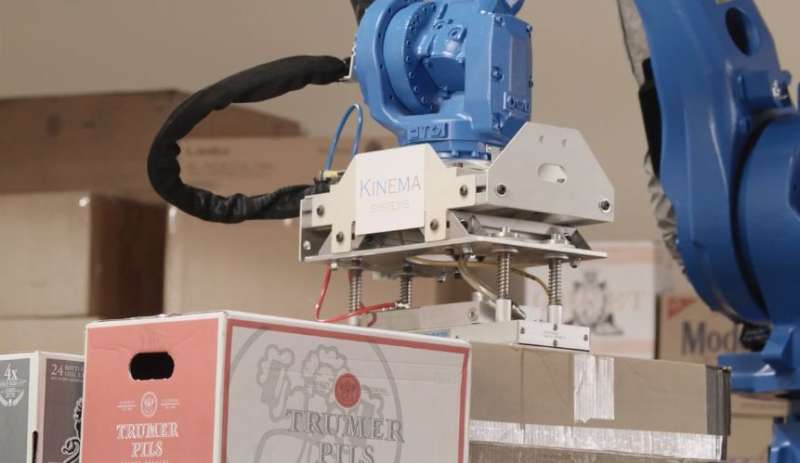April 8, 2016 weblog
Startup eyes industrial robotics payoff in random picking

Moving boxes around is tedious but easy for humans; it is not tedious but it may not be at all easy for robots. Advances in using robots on the factory and warehouse floor are in evidence thanks to advanced vision technology and gripping techniques. Robotics experts nonetheless see room ahead for improvements.
Silicon Valley startup Kinema Systems is aggressively trying to make a real difference, and the company has announced a self-training, self-calibrating robot picking solution. The company calls it Kinema Pick and said it can be configured easily using a browser-based GUI.
Evan Ackerman in IEEE Spectrum commented on the getting-started stages: "The robot does pretty much everything by itself—you just need to set up the vision system, tell it where the pallet is going to be, and then tell it where you want the boxes to end up. That's it."
Kinema Pick is for "robotic depalletizing" said the press release. Translation: It is for picking up boxes off the pallets and putting them somewhere else.
Kinema Pick performs on multi-SKU, single-SKU and even random pallets of boxes, said the release.
And here we come to a key point of interest. The company said the "holy grail" of industrial robotics lay in random picking. "Kinema Pick addresses a critical need in the e-commerce, logistics and distribution industry for robotic picking solutions capable of dealing with unstructured random pallets of boxes."
Evan Ackerman discussed this too in IEEE Spectrum: Getting an industrial robot arm to do its job is one thing, in that the arm is working with the same pallets with the same boxes over and over again. Now a slice from real life: "E-commerce companies are getting pallets with all kinds of random boxes tightly jammed on there however they'll fit, which is too much variability for most robots to handle. So, humans have to do it, by hand, and that's slow and costly."
Ackerman said, "a team of humans can pick a box off of a randomized pallet and place it on a conveyor belt on average once every 6 seconds, and Kinema can beat that."
How this works: IEEE Spectrum said the Kinema team uses object recognition approaches to tell one box from another. "Once it picks a box for the first time, it builds a model of what the box looks like, and uses that to speed up its pick the next time," CEO Sachin Chitta told IEEE Spectrum.
In MIT Technology Review, Will Knight further reported that Chitta, said the robot was using a combination of 2-D and 3-D vision.
What's next: They are focused on the depalletizing pilots, said Ackerman, and once that stage is completed, they expect the commercial system to be available through integrators by the end of this year.
The Kinema solution might attract businesses looking to shave time off deliveries. Ken Goldberg, a professor at the University of California, Berkeley, who specializes in robotics and machine learning, was quoted in MIT Technology Review: He said the company's approach "could be very valuable in contemporary logistics, where the aim is to compress delivery time from days to hours."
More information: www.kinemasystems.com/
© 2016 Tech Xplore




















